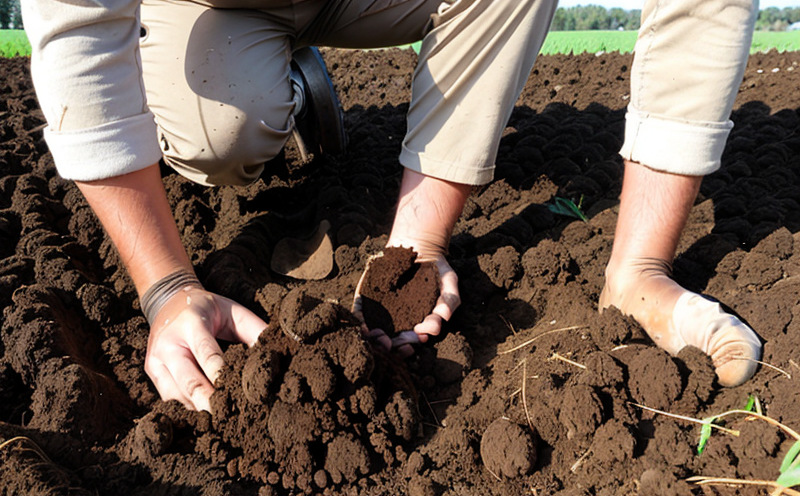Soil Acidity (Buffer pH) Testing
The measurement of soil acidity, often referred to as pH, is a critical parameter in agricultural and forestry testing. Soil acidity significantly influences the availability of essential plant nutrients, affecting crop growth, yield, and overall health. The buffer pH test specifically evaluates the soil's capacity to neutralize acids, which is crucial for understanding long-term soil behavior under various conditions.
Buffer pH differs from immediate pH as it reflects the soil’s resistance to changes in acidity. This characteristic is particularly important when considering fertilizers and other amendments that can alter soil chemistry. Understanding buffer pH helps in predicting how the soil will respond over time, ensuring sustainable agricultural practices.
The test involves a series of steps that begin with thorough soil sample preparation. Samples are typically collected from multiple points to ensure a representative mix. These samples undergo rigorous analysis using advanced spectrophotometric and potentiometric techniques. The standard procedure adheres to international standards such as ISO 17266-1, ensuring consistent and reliable results.
The significance of buffer pH testing extends beyond immediate agricultural applications. It plays a pivotal role in long-term soil health management strategies, aiding in the development of sustainable farming practices. By understanding how soil buffers against changes, farmers can make informed decisions about irrigation, fertilization, and crop selection to enhance productivity without degrading soil quality.
Environmental aspects also come into play, with buffer pH testing contributing to broader sustainability goals. Sustainable agriculture practices that include buffer pH evaluation help in reducing the environmental impact of agricultural activities by minimizing nutrient runoff and promoting healthier ecosystems.
Environmental and Sustainability Contributions
The importance of soil acidity (buffer pH) testing cannot be overstated, especially given its role in sustainable agriculture. By accurately measuring buffer pH, farmers can avoid overapplying fertilizers, which not only saves on costs but also reduces the risk of nutrient leaching into nearby water bodies.
Buffer pH testing supports environmental stewardship by promoting responsible use of natural resources. It helps in identifying areas where soil amendments are most needed and ensures that these materials are applied efficiently without causing harm to the environment. This practice aligns with broader sustainability goals, contributing to a healthier planet and more resilient agricultural systems.
Additionally, buffer pH testing is integral to the development of precision agriculture techniques. By integrating this data into decision-making processes, farmers can optimize resource use and reduce waste, leading to more efficient land management practices. This not only enhances crop yields but also contributes positively to environmental conservation efforts.
Competitive Advantage and Market Impact
In the competitive landscape of agricultural testing, buffer pH testing offers a strategic advantage by providing actionable insights into soil health. Accurate buffer pH data enables farmers and agronomists to tailor their practices precisely, leading to higher crop yields and improved product quality.
By leveraging advanced testing methods that adhere to international standards like ISO 17266-1, laboratories can ensure precision and reliability in their results. This not only enhances trust with clients but also sets a benchmark for service excellence. The ability to offer comprehensive soil analysis, including buffer pH, differentiates service providers in the market.
The demand for sustainable agricultural practices is growing, driven by increasing consumer awareness of environmental issues. Providers that can demonstrate robust buffer pH testing capabilities are more likely to attract clients seeking solutions that align with these trends. This not only enhances brand reputation but also opens up new business opportunities in the rapidly evolving agricultural sector.
Use Cases and Application Examples
| Application Example | Description |
|---|---|
| Fertilizer Recommendations | Accurate buffer pH testing helps in recommending the right type and amount of fertilizer to minimize nutrient loss and optimize crop growth. |
| Irrigation Management | Determining buffer pH is essential for managing irrigation levels, ensuring that water does not exacerbate soil acidity issues. |
| Soil Health Evaluation | Buffer pH testing provides a comprehensive view of soil health, aiding in the assessment and improvement of long-term agricultural sustainability. |
| Farm Planning | Data from buffer pH tests can inform farm planning decisions, helping to identify areas that require specific interventions for optimal crop performance. |
| Environmental Monitoring | Regular testing helps monitor the impact of farming practices on the environment, ensuring compliance with sustainability goals. |
| Application Example | Description |
|---|---|
| Sustainability Reporting | Incorporating buffer pH data into sustainability reports provides stakeholders with transparent information on environmental impact and management practices. |
| Crop Rotation Analysis | Buffer pH testing helps in analyzing the suitability of different crops for various soil conditions, ensuring optimal crop performance. |
| Pesticide Effectiveness Assessment | Evaluating buffer pH is crucial for assessing pesticide effectiveness and minimizing environmental risks associated with overuse or misuse. |
| Land Use Planning | Data from buffer pH tests can guide land use planning decisions, ensuring that soil health is a key consideration in agricultural development. |





